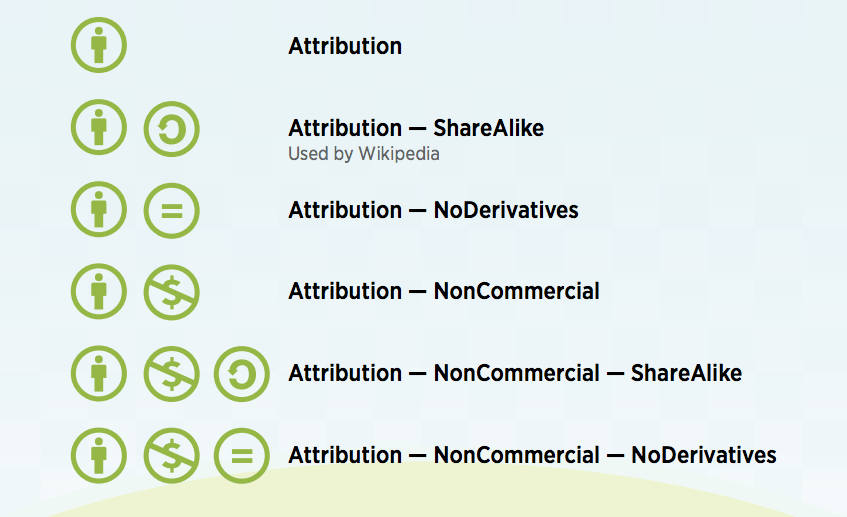Creative Commons
Create and share deliberately.
What is It?
Creative Commons is a type of license that allows content creators to deliberately and clearly communicate how they want others to be able to use and reuse their work. US Copyright Law protects creative works the moment they are released in a fixed and tangible form. This protection is automatic and requires no intervention on the part of the creator. The issue with automatic copyright is that sometimes we, as creators, want to share our work with others and allow them to use and reuse it for themselves. Creative Commons is an easy way communicate that.
Creative Commons provides a collection of licenses to suit a variety of circumstances. The licenses are comprised of combinations of conditions which include; Attribution (by), ShareAlike (sa), NonCommercial (nc), and NoDerivatives (nd). The licenses are available in both human-readable and machine-readable formats. Human-readable versions are written by legal professionals in a language that is easy for the average person to understand. Machine-readable versions of licenses are simultaneously available so that CC-licensed work is easier to find on the Web.

How Can I Use Creative Commons in My Course?
As an instructor you can use Creative Commons-licensed photos, videos, academic texts and more to supplement your course. Websites such as Flickr, Youtube, Vimeo, the Internet Archive and PLOS (Public Library of Science) are great places to start, but you can find CC-licensed content in many other places. You can also use Creative Commons licenses to share great resources you create for your course. Sharing is more than a way to give back to the learning community. It is also a great way to market you and your course to an audience outside the university. Creative Commons licenses point back to you, the original creator. Students can use CC-licensed content in their research, in presentations, in remixed artwork and so much more. Having conversations with students about Creative Commons and the broader concepts of responsibly using copy-protected material goes hand in hand with teaching the importance of citation.
To license your work with a Creative Commons license:
- Go to CreativeCommons.org.
- Choose a license by answering a few questions using their web form.
- Link to the license you select
- If you have a website, copy+paste the HTML provided to you on the Creative Commons site, to your site
Download a printable handout with instructions for marking and licensing your content with Creative Commons.
If you’d like to learn more in-person, please attend on of our iTeach+ Workshops or feel free to contact a Designer with questions.
Questions and Considerations
Remember that by creating something and making it available in a fixed form such as a poem, an essay or a video tutorial for your class, it is immediately subject to US Copyright law. If you want others to be able to use, reuse and remix your work a Creative Commons license will provide a way to clearly communicate your willingness to share with them.
Watch:
Creative Commons explained
Wanna Work Together? from Creative Commons on Vimeo.
Pays tribute to the people around the world using CC licenses to build a better, more vibrant creative culture.
Research Foundations
Lessig, L. (2002). The future of ideas: The fate of the commons in a connected world. New York, NY: Vintage.
Loren, L. P. (2006). Building a reliable semicommons of creative works: Enforcement of creative commons licenses and limited abandonment of copyright. Geo. Mason L. Rev., 14, 271.
